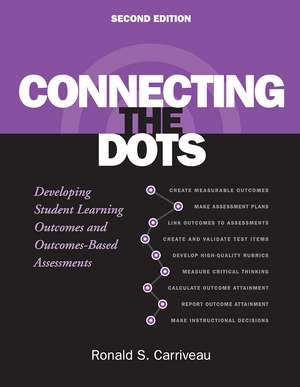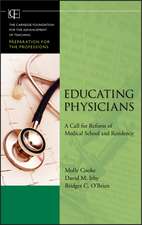Connecting the Dots: Developing Student Learning Outcomes and Outcomes-Based Assessment
Autor Ronald S. Carriveauen Limba Engleză Paperback – 12 oct 2016
| Toate formatele și edițiile | Preț | Express |
|---|---|---|
| Paperback (1) | 168.47 lei 6-8 săpt. | |
| Taylor & Francis – 12 oct 2016 | 168.47 lei 6-8 săpt. | |
| Hardback (1) | 993.23 lei 3-5 săpt. | |
| Taylor & Francis – 18 oct 2016 | 993.23 lei 3-5 săpt. |
Preț: 168.47 lei
Preț vechi: 205.96 lei
-18% Nou
Puncte Express: 253
Preț estimativ în valută:
32.24€ • 34.47$ • 26.88£
32.24€ • 34.47$ • 26.88£
Carte tipărită la comandă
Livrare economică 17 aprilie-01 mai
Preluare comenzi: 021 569.72.76
Specificații
ISBN-13: 9781620364802
ISBN-10: 1620364808
Pagini: 128
Dimensiuni: 222 x 285 x 8 mm
Greutate: 0.24 kg
Ediția:2
Editura: Taylor & Francis
Colecția Routledge
Locul publicării:Oxford, United Kingdom
ISBN-10: 1620364808
Pagini: 128
Dimensiuni: 222 x 285 x 8 mm
Greutate: 0.24 kg
Ediția:2
Editura: Taylor & Francis
Colecția Routledge
Locul publicării:Oxford, United Kingdom
Public țintă
Postgraduate and Professional Practice & DevelopmentNotă biografică
Ronald S. Carriveau is the Outcomes, Assessment, and Measurement Specialist, and QEP Assistant Director, At the Center for Learning Enhancement, Assessment, and Redesign, University of North Texas, and is the assistant director for the university's Quality Enhancement Plan for accreditation. Dr. Carriveau earned a Ph.D. in Educational Psychology. He has taught in the public school system, held the position of associate professor at the university level, served as director of assessment at a large school district and at the state department of education, and was a test development manager for a national test publisher. He has consulted nationally and internationally.
Cuprins
PrefaceAcknowledgments Introduction 1)Developing Student Learning Outcomes 2)Templates for Writing Test Questions 3)Developing an Overall Assessment Plan and Test Blueprint 4)Writing Multiple-Choice Test Items 5)Writing Constructed-Response Items 6)Writing and Using Scoring Rubics 7)Measuring Critical Thinking with Multiple-Choice Items 8)Reporting Results With the Three-Level Model 9)Applying the Three Level Model at the Institutional Level and Beyond References Index
Recenzii
REVIEWS OF THE FIRST EDITION
"For individual professors, as well as departments or faculties as a whole, this book is an invaluable guide for course and curricular development."
Ellen S. Pryor, Professor and Associate Dean, UNT Dallas College of Law
“I’ve yet to find a faculty member that did not rave about the value of the question templates when devising test items to monitor the achievement of learning outcomes in their courses.”
Bob Smallwood, Assistant to the Provost for Assessment, University of Alabama
“I reviewed several books and found yours to fit our needs best. It is well written, relatively short, gets to the point, and after piloting the use with a group of faculty, well received.”
Paul Force-Emery Mackie, Professor, Minnesota State University, Mankato
"For individual professors, as well as departments or faculties as a whole, this book is an invaluable guide for course and curricular development."
Ellen S. Pryor, Professor and Associate Dean, UNT Dallas College of Law
“I’ve yet to find a faculty member that did not rave about the value of the question templates when devising test items to monitor the achievement of learning outcomes in their courses.”
Bob Smallwood, Assistant to the Provost for Assessment, University of Alabama
“I reviewed several books and found yours to fit our needs best. It is well written, relatively short, gets to the point, and after piloting the use with a group of faculty, well received.”
Paul Force-Emery Mackie, Professor, Minnesota State University, Mankato
Descriere
This book is designed to help faculty and institutions of higher education meet these demands by obtaining, managing, using, and reporting valid outcome attainment measures at the course level; and mapping outcome attainment from the course level to departmental, degree program, and institutional levels, and beyond.








